 / destiny.quartet
INSTAGRAM: https://www.instagram.com/destiny.qua...
TIDAL: https://tidal.com/browse/artist/15107866
SPOTIFY:https://open.spotify.com/artist/3LSB9...
WEBSITE: http://destiny.bg/bg
Music Angel Viloldo
Arrangement Maurizio Abeni
/ destiny.quartet
INSTAGRAM: https://www.instagram.com/destiny.qua...
TIDAL: https://tidal.com/browse/artist/15107866
SPOTIFY:https://open.spotify.com/artist/3LSB9...
WEBSITE: http://destiny.bg/bg
Music Angel Viloldo
Arrangement Maurizio AbeniIt's all about the classical music composers and their works from the last 400 years and much more about music. Hier erfahren Sie alles über die klassischen Komponisten und ihre Meisterwerke der letzten vierhundert Jahre und vieles mehr über Klassische Musik.
Total Pageviews
Wednesday, September 11, 2024
Destiny El Choclo
 / destiny.quartet
INSTAGRAM: https://www.instagram.com/destiny.qua...
TIDAL: https://tidal.com/browse/artist/15107866
SPOTIFY:https://open.spotify.com/artist/3LSB9...
WEBSITE: http://destiny.bg/bg
Music Angel Viloldo
Arrangement Maurizio Abeni
/ destiny.quartet
INSTAGRAM: https://www.instagram.com/destiny.qua...
TIDAL: https://tidal.com/browse/artist/15107866
SPOTIFY:https://open.spotify.com/artist/3LSB9...
WEBSITE: http://destiny.bg/bg
Music Angel Viloldo
Arrangement Maurizio AbeniMonday, September 9, 2024
Lynda Carter - Rhumba Girl (1981)
Sunday, September 8, 2024
RITA HAYWORTH // tribute video
Tina Turner - The Best (Live in Barcelona, 1990)
Friday, September 6, 2024
A musical tribute for pianist Nena del Rosario-Villanueva
The first highlight of her Curtis years was winning a piano competition sponsored by the New York Times. That was her Carnegie Hall debut at age 12!
By Teo Guerrero

Three years after she passed away in June 2021, pianist Nena de Rosario-Villanueva will be given a special birthday tribute on Sept. 22, at 2 p.m. at the Manila Pianos and at 5:30 p.m. at the Klavierhaus in New York.
Called “Nena: Remembering Nena del Rosario-Villanueva, the tribute” will be highlighted with a special lecture on her life and works by Dr. Alegria Ferrer.
For the Manila Pianos tribute, the featured artists are pianists Danica Mae Antazo and Pauline Aguila, with a special number from Elnora Halili.
The New York artists paying tribute to Villanueva on the same date are pianist Jovianney Emmanuel Cruz, soprano Margarita Gianelli, and pianist Rene Dalandan.
Dr. Ferrer’s lecture will most likely touch on her early musical journey, starting in Iloilo City, which saw her amazing transformation as the country’s first piano prodigy rising to prominence after the Second World War.
She hid with her family in nearby Iloilo mountains during the Second World War, but it seemed she couldn’t part with the piano in between war and peace.
A story was told that, during the war years, her mother, Gertrudis Hautea del Rosario (a student of MSO founder Alexander Lippay and a graduate of the UP Conservatory of Music), had asked for 20 sturdy men to carry the family upright piano to their hiding place, crossing rice fields and going up and down verdant hills.
An intense love affair with the piano while her country was at war made her an easy choice to play during the first Independence Day celebration in 1946. It also resulted in her orchestral debut with the Manila Symphony Orchestra under Herbert Zipper and with the Quezon City Philharmonic under Maestro Ramon Tapales.
It wasn’t long before she became the first Filipina soloist of the famous Seiji Ozawa on his first visit in the country with the NHK Symphony.
When she first met Dr. Zipper, the young Nena could already perform the fiendishly challenging Chopin Etudes and two concertos without score.
Before she left the country for further studies abroad, she studied under Victorina Lobregat and James Milne Charnley.
After a farewell concert at the UST Gymnasium, del Rosario headed for the US, where she was accepted at the famous Curtis Institute of Music at age 11 under the tutelage of the eminent Russian pedagogue Isabelle Vengerova, she attended masterclasses with no less than the legendary Vladimir Horowitz and Abrams Chasin.
The first highlight of her Curtis years was winning a piano competition sponsored by the New York Times. That was her Carnegie Hall debut at age 12!
At age 15, she became finalist in the season’s “Musical Talent in Our Schools” series and returned to Carnegie Hall with the New York Philharmonic Symphony Orchestra under Igor Buketoff.
The competition was sponsored by The New York Times and Station WQXR.
With the onset of the radio in the early ’50s, Del Rosario became the first Filipino pianist to be introduced to mainstream audiences throughout the US. She appeared on CBS Radio no less than seven times starting with her first appearance at age 12.
The program Gateways to Music was broadcast nationwide followed by appearances on Voice of America and The Green Room Series with the CBS Symphony.
When del Rosario returned to the Philippines in the mid-’50s after she acquired an Artist’s Diploma at Curtis, she was the celebrity pianist of the hour.
During her time, the FEU Auditorium was the cultural center. Her last concerts in Manila in the first decade of the new millennium were at the Francisco Santiago Hall and many times at the Cultural Center of the Philippines.
“Nena del Rosario-Villanueva was a gentle and sweet lady. It was an honor to have worked with her and Maestro Oscar Yatco,” recalled Angel Nacino of the Manila Chamber Orchestra (MCO) Foundation, which had a concert series at the Francisco Santiago Hall. “She is a legend! She was one of those I worked with who could play from memory in her senior years. She was one of those who I worked with who could perform in a sparkly low-back gown, too! And with that back, I could see clearly from backstage how her muscles worked together and connected with those powerful hands and fast fingers. She requested me to bring her nine-foot-long piano to our Santiago Hall. How could I say no? Nine men had to carry the piano because our lifter could accommodate only a seven-foot piano.”
When del Rosario passed away in 2021, her brother Mariano del Rosario III could only remember her thus: “She was relentless in the desire and design to further her piano skill sets and went to Paris to continue her studies. A simple yet poignant experience I recall is when she was rehearsing in one of the concert halls, and a custodian checking the building heard her play. He was so taken by her exquisite practice and was so moved by the music during her practice that he gave her access to the hall at any time. He was so impressed. Losing Nena means I’ve lost a friend, a love of my life from childhood. I have lost a sister who would do anything for me or a friend, a kind person who cares for everyone even before caring for herself. A sister proud of her children and their accomplishments, a mother and a grandmother who cared and loved with all her heart.”
For inquiries on the Sept. 22 tribute at the Manila Pianos, call 0917-800-9357.
Edvard Grieg: 6 Poems by Henrik Ibsen
by Georg Predota, Interlude
Leipzig Connection
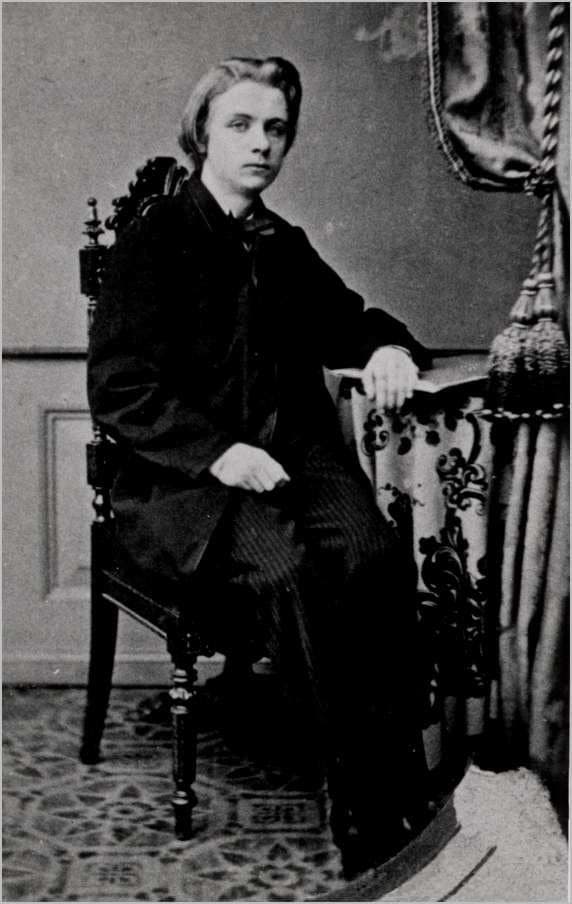
Edvard Grieg, 1858
As Grieg famously stated, my songs are “written with my life-blood.” His early music clearly reflects his studies in Leipzig, and he only discovered folk music in the mid-1860s. Taking his inspiration from two pioneers of Norwegian folk music, “Grieg was the chosen one, who wooed the princess from the mountain and won half the kingdom.”
Grieg did acknowledge Schumann as his mentor, as the “Poetic conception plays the leading part to such an extent that musical considerations are technically important are subordinated, if not entirely neglected.” Grieg’s ability to write songs is attributed to the influence of his wife Nina, and when they had relationship tensions, he composed no songs at all.
Songs from the Heart
As he wrote to a friend, “I do believe I have more talent for song composition than for any other genre in music. From when does it come then, that the song plays such a prominent role in my output? Quite simply for the reason that I, like other mortals, on one occasion in my life, was brilliant.”
And Grieg continues, “The brilliance was love. I fell in love with a young girl with a wonderful voice and similarly wonderful interpretation. This girl became my wife and life’s partner right to this day. She has been, for me, the only true interpreter of my songs.”
Grieg and Poetry
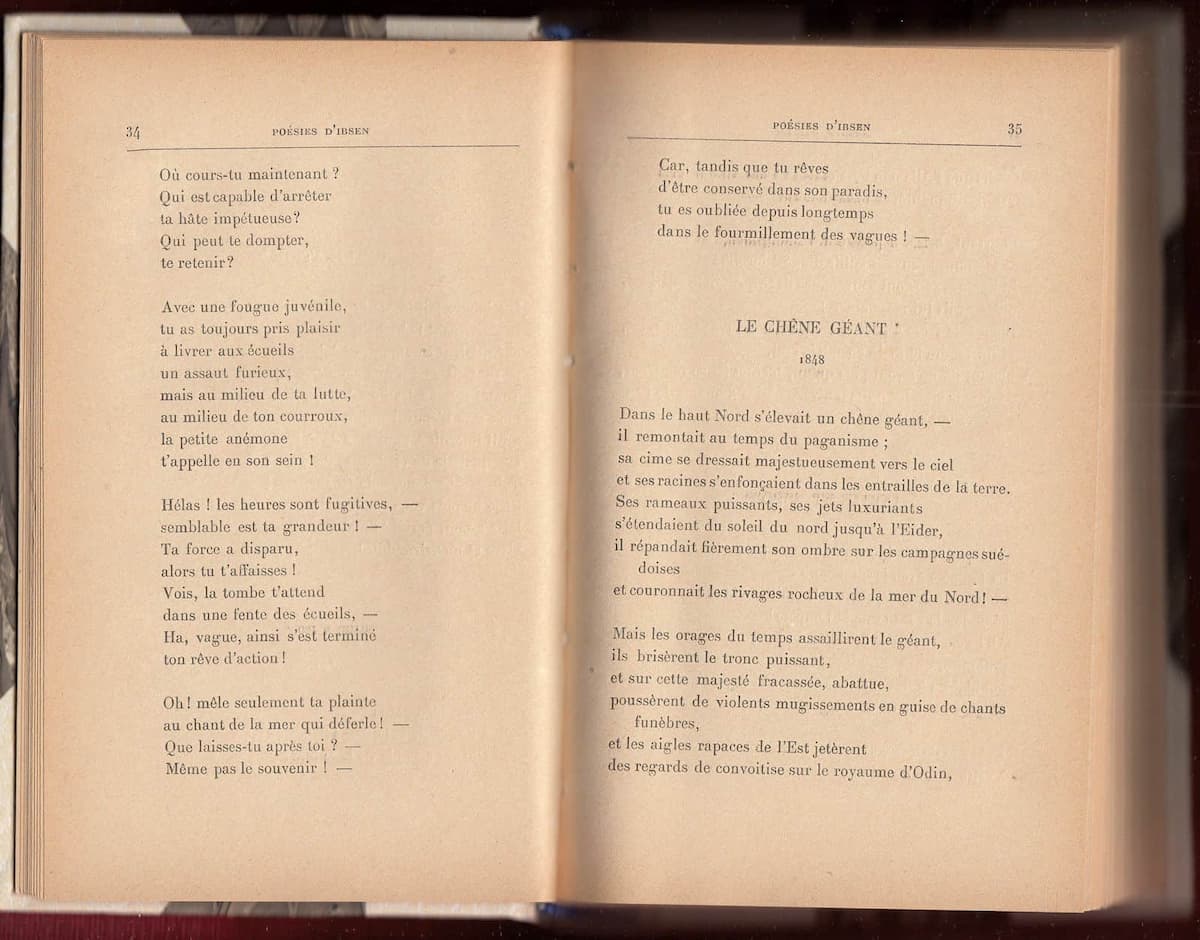
1907 Poésies by Henrik Ibsen
Grieg was very receptive to all kinds of poetry, even when, on occasions, he selected rather inferior verse. He always composed music to suit the intrinsic melody of the words, whatever the language. A scholar writes, “there is something in the Scandinavian psyche which appears to regard being happy as tempting fate, so a darker feeling is often to be detected behind the seemingly innocuous.”
Writing to a friend, Grieg explains, “For me, it is important when I compose songs, not first and foremost to make music, but above all to give expression to the poet’s innermost intentions. To let the poem reveal itself and to intensify it was my task. If this task is tackled, then the music is also successful. Not otherwise, no matter how celestially beautiful it may be.”
Grieg and Ibsen
Ibsen had been impressed by Grieg’s musical talents from their first meetings in Rome in 1866 and also by the young composer’s perception of literature. The collaboration on Peer Gynt turned out to be a major headache for Grieg, both in terms of composition and eventual performance. Yet, as we know, it became a qualified success.
It is hardly surprising, therefore, that Grieg turned to Ibsen’s poetry for possible song texts. Grieg explained that the “truth wrapped up in rhyme is easier to accept than it is in prose, and it seems that Ibsen was more able to give direct expression to his thoughts in verse than in prose.”
Ibsen Poetry
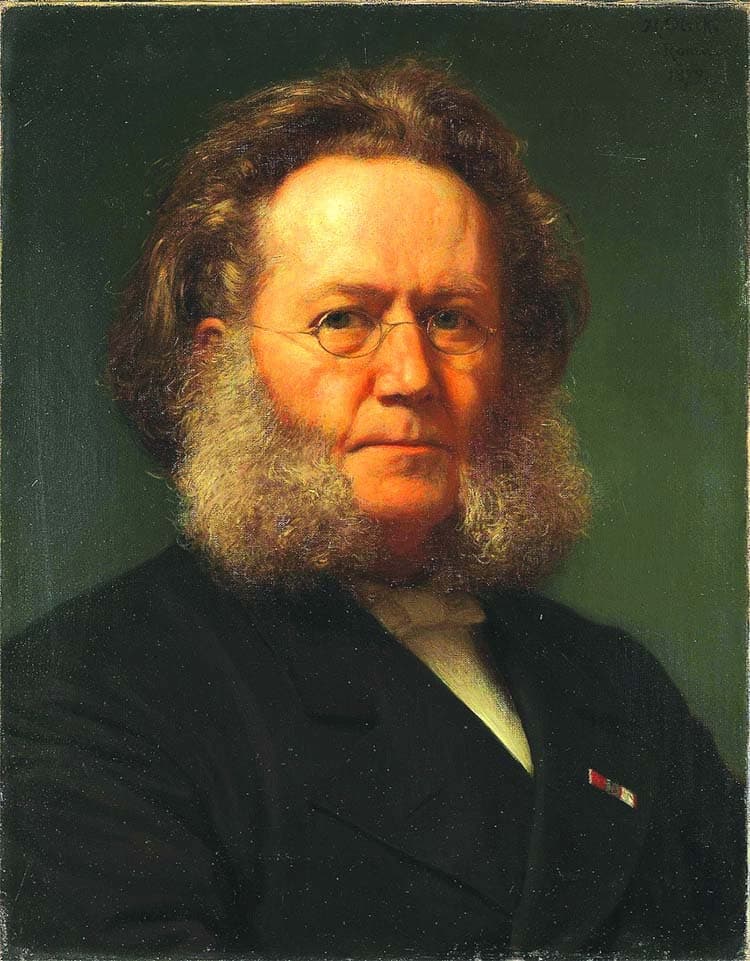
Henrik Ibsen
Ibsen’s poetry, much revised prior to publication, shows a wide diversity of styles. It ranges from purely elegiac to imagery and expression, songs in verse form, plays, and narrative poetry. And let’s not forget the occasional political verse, such as the poem on Abraham Lincoln’s assassination.
Almost all of Ibsen’s poetry is marked by concentration of content. “He most often uses nouns and verbs with few accompanying adjectives or adverbs. He makes use of contrast and antitheses, and the concentration is not just of ideas, frequently taken to their limits throughout a poem, but it is also to be found in the imagery and vocabulary he chooses.
6 Poems by Ibsen, Op. 25
In 1876, Grieg found Ibsen’s fateful poetry a match for his own state of mind. He had lost both his parents within a short period of time, “each strangely dying a day before an advertised concert, which then had to be cancelled.” In addition, his marriage was going through a rather unsettled period, and Grieg poured his anguish into his music.
This prevailing mood of despair drove Grieg to Ibsen’s verse, and the six poems set in his Op. 25 convey his melancholy in a most inspired way. “The understated rife in the poetry, the restraint of the emotion and the concentration of ideas are all mirrored in the music.”
My thoughts were of her
Every light summer night,
But the road leads to the river
By the dewy alder.
Do you feel a shudder and anguish,
Can you bewitch her lovely senses,
So that into great churches and halls
She will be minded to enter with you.
I commend forth the spirit from the deep;
He led me away from God,
But when I became his master
She became my brother’s bride.
Into great churches and halls
I played myself
And the shuddering and anguish of the falls
Was never far from my mind.
“Minstrels” is based on a familiar Norwegian legend of a musician who is taught great powers of interpretation by a water sprite, only to find himself having to repay the debt with his own happiness. A literary critic wrote, “the poem presents a view of Ibsen as a haunted man, who is always seeking to break through to the light, is often beset by the doubt whether darkness might not, after all, be the natural abode of men.”
Grieg’s setting has been described as one of his finest achievements. There is great vocal simplicity in the opening measures supported by a straightforward accompaniment. As the song modulates, we learn about the minstrel being lured to the river. The central part features recitative-like declamation, with chromatic movements in the inner part of the piano mirroring the development of the story. The Minstrel finally accepts his fate but the unsettled nature of the song also hints at rumours “that Nina Grieg was having an affair with Edvards’ brother John.”
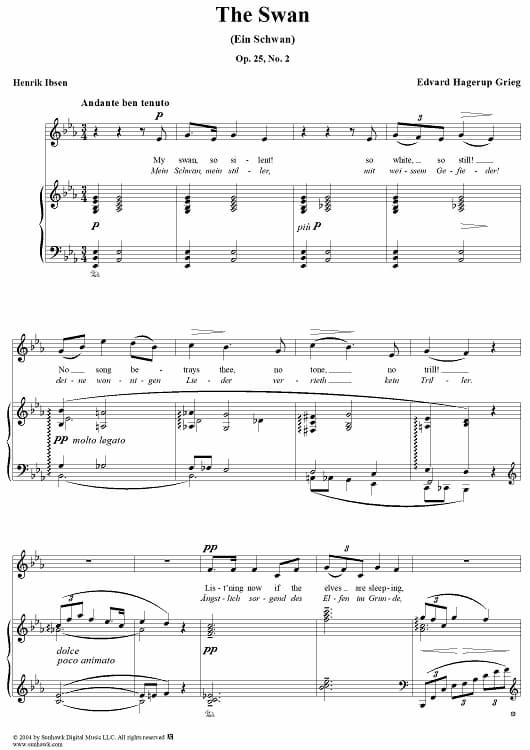
Edvard Grieg’s 6 Poems by Henrik Ibsen, Op. 25 “The Swan”
My white swan
Silent and still,
Neither form nor drill
Gives promise of your voice.
Anxiously protecting
The sprite who sleeps,
Every listening
You glided past.
But the last meeting
When oaths and promises
Were but lies
Then, then it was heard.
In the birth of those tones
You ended your path.
You sang in death;
For you were a swan.
In Norse mythology and literature, and in Celtic writing, the motif of swans linked by a silver chain is “the symbol of divine beings in metamorphosis.” For Ibsen, the swan was a symbol of the soul and “typifies the Norse belief in the dark unknown passions and haunting obsessions above which life must be raised and against which it must be defended.”
The Grieg setting is marked “slowly and restrained,” and there is a great atmosphere of stillness. Grieg presents a very basic harmonic structure, but the accompaniment chords have altered chromatic notes, describing the swan movement. Grieg shows a natural restraint, which he powerfully casts aside in the fortissimo climax. Grieg once conducted the orchestrated version of the song with the Belgian singer Grimaud, “performing wonderfully well with great dramatic accent.” Grieg commented that “No Norwegian would have dared to give such an interpretation because our nature would have to struggle with our national shyness.
I called you my bearer of good tidings;
I called you my star.
You were sent from God.
Good tidings went forth;
A star, a cascade of stars,
That died in the distance.
“Album Verse” is one of the most concise poetic and musical settings. In fact, as it is only twelve measures long, it is Grieg’s shortest art song. Despite this brevity, Grieg still manages to construct a lyrical piece in ABA form. This brevity somehow vails the meaning, as the reader is only aware that a beloved messenger of joy, is no more.
Grieg musically matched this utter despair with a sighing and broken melody in the minor key, with syncopated chords in the right-hand accompaniment. Grieg is once more primarily concerned with declamation and not with the beauty of the vocal line. As the verse has a rather elusive quality, seemingly an episode without a beginning or end, the unexpected lyricism in the left-hand accompaniment does come as a surprise.
Lock, Marie, what I bring
The flower with its white wings.
Floating on the gentle current
Dreamily it swam in the spring.
Will you take it home
And pin it to your bosom, Marie;
Behind its petals hides
A deep and calm wave.
Child, be wary of the current in the brook,
Dangerous it is to dream there!
The water-sprite pretends that he is sleeping;
Lilies play above.
Child, your breast is the current of the stream.
Dangerous it is to dream there!
Lilies play above,
The water-sprite pretends that he is sleeping.
The mood somewhat lightens in the fourth song titled “With a Water Lily.” Yet, below the playfulness in both the poem and music, there is a hint of darker forces, and the symbol of the water-sprite is used once again. The accompaniment seems to make a nod towards Schumann, and the vocal part is doubled in both hands for the entire song. It has been described as “racing off like thoughts ahead of the spoken word, to be brought back to heel by the voice.”
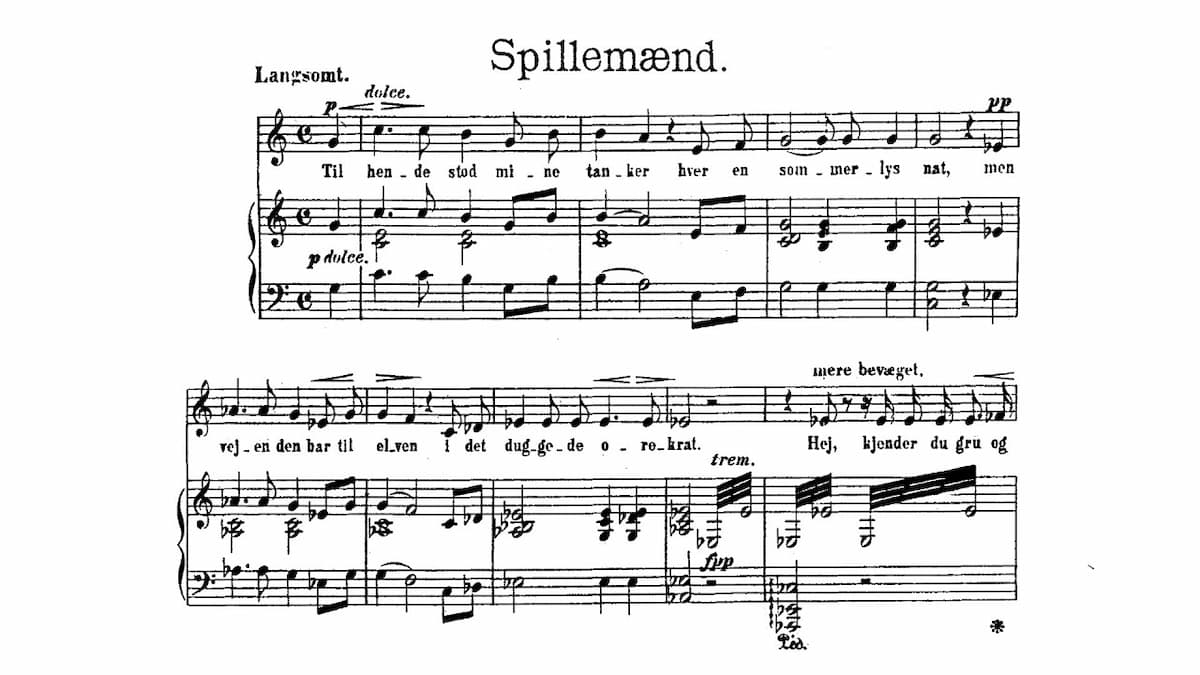
Edvard Grieg’s 6 Poems by Henrik Ibsen, Op. 25
The supernatural water sprite appears in the third stanza of the poem and, in this sense, represents the dangers of love. The music mirrors this danger by plunging from a charming melody into the darker minor mode. The melody is taken down in spiralling chromatic phrases through various transitions, with the music eventually returning to the playful opening. “The song, unlike the poem, ends with a sense of happiness and security.
We accompanied the last guests to the gate;
The night wind took the last farewells.
Tenfold deserted lay harbour and house,
Where, previously, the music had intoxicated me.
It was a feast just before the black night;
She was only a guest and now she is gone.
“Gone” presents a brief and elusive world. The desolation of the house and garden mirrors that of the poet, and it has been suggested that with this concise poem, “Ibsen could rival Heine in conveying vivid impressions with great simplicity.” In only 13 measures, Grieg captures the haunting quality once more in short phrases and in a recitative-like style of declamation.
A Birdsong
On a lovely spring day we walked up and down the avenue;
The forbidden step drew me like a mystery.
And the west wind blew and the sky was blue;
In the limetree a mother-bird sat and sang for her young.
I painted poetic images with playful brushstrokes;
Two brown eyes shone and smiled and listened.
Above us we can hear twittering and merriment;
But we two took a fond farewell and never met again.
And as I wander alone up and down the avenue
I am never left in peace by the little feathered creatures.
Mistress sparrow has been sitting and listening while we innocently walked
And she has written a poem about us and set it to music.
It is in the bird’s mouth; for under the leafy roof
Every beak sings of the bright spring day.
The concluding song conveys a truly playful mood. The poem tells of two lovers meeting under the trees while the birds watch and sing around them. It is reported that Ibsen wrote the poem when he was in love with a sixteen-year-old girl. When they were caught, “Ibsen with heroic timidity apparently ran away.” In Grieg’s setting, this peaceful and cheerful song provides a new spring “after a dark and hard winter.”
In his Six Poems by Henrik Ibsen, Edvard Grieg was clearly not inspired by the poet’s flight of fantasy but rather by the text’s austerity and seriousness. These short, autumnal pictures are written in a highly charged symbolic language, as the text and music relate to how life’s crises can only be overcome with the aid of music.
Anton Bruckner (1824-1896) Happy 200th Birthday Anton Bruckner
by Georg Predota, Interlude
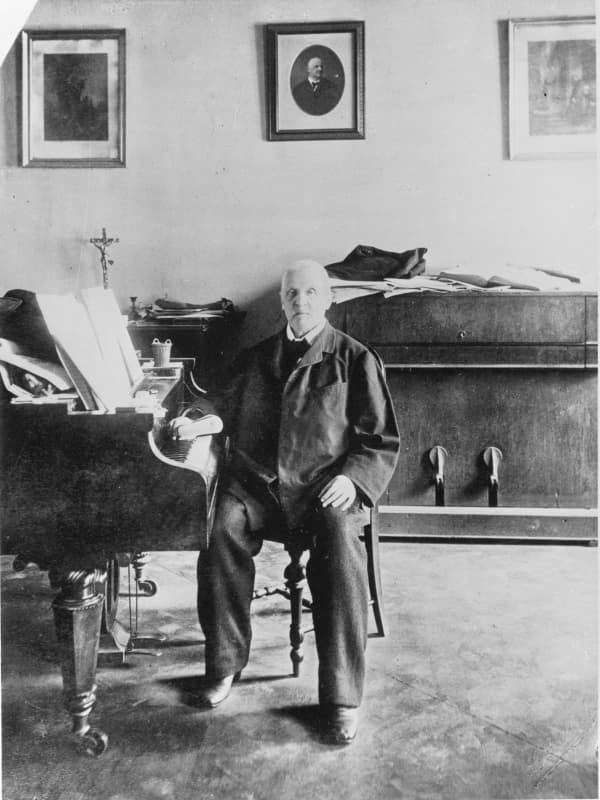
Anton Bruckner © Ludwig Grillich
His compositions, relying on a highly idiosyncratic and expansive musical style, helped to define contemporary musical radicalism. A solitary man, preferring the rural surroundings of Upper Austria to the urban environments of Linz and Vienna, Anton Bruckner remains an enigma, even as we celebrate the 200th anniversary of his birthday.
Ancestry and Study
The Bruckner family lived in a small, isolated farming community for over four centuries. His grandfather was a broom-maker, and just like Schubert, Anton was a schoolmaster’s son. His father, also named Anton, did everything in his power to stimulate his son’s musical talents. As the composer later recalled, “my favourite place growing up was in church, next to my father on the organ bench.”
Young Bruckner showed some obvious talent for music, and at the age of 10, it was decided that he should be sent to musical studies with his godfather Johann Baptist Weiss. Bruckner received his first serious lessons in harmony, figured bass, and organ and violin playing. In addition, young Anton was introduced to a wider repertory of church music. After his father’s death in 1837, Bruckner was sent to the monastery of St. Florian as a chorister.
St Florian Monastery
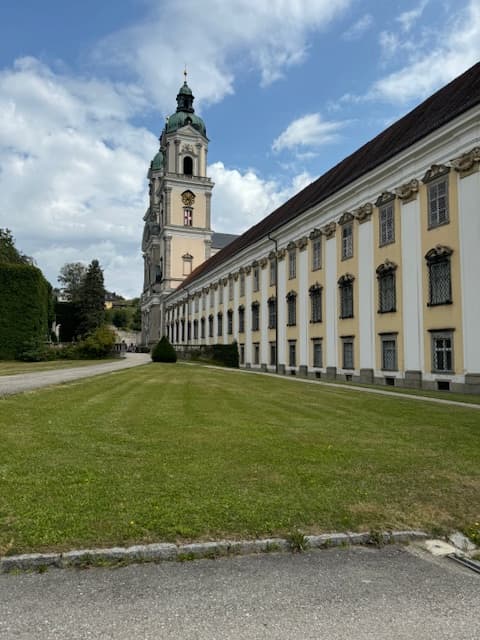
St. Florian Monastery
Bruckner’s first stay at the Augustinian monastery of St. Florian lasted three years. The monastery was a center for the arts and science, and as part of the centuries-old music tradition, it housed the largest organ in the Danube Monarchy. Bruckner was in awe of the great instrument, later to be called the “Bruckner Organ,” and he greatly excelled in organ improvisation. He also received lessons in reading, writing, arithmetic, and organ and piano instruction.
As Paul Hawkshaw writes, “if his Roman Catholicism had already been firmly established during his boyhood in Ansfelden, it was certainly reinforced at St. Florian. The Baroque halls of the monastery were to be a source of spiritual strength and inspiration for the rest of his life.” Bruckner was a devoutly religious man who kept a log of his daily devotions and prayed before each performance. His faith in the spiritual journey towards the afterlife became a process that decisively shaped his compositional imagination as he channeled profound spiritual messages that elevated the music to the level of an undistracted prayer.
Teacher Training and Return to St. Florian
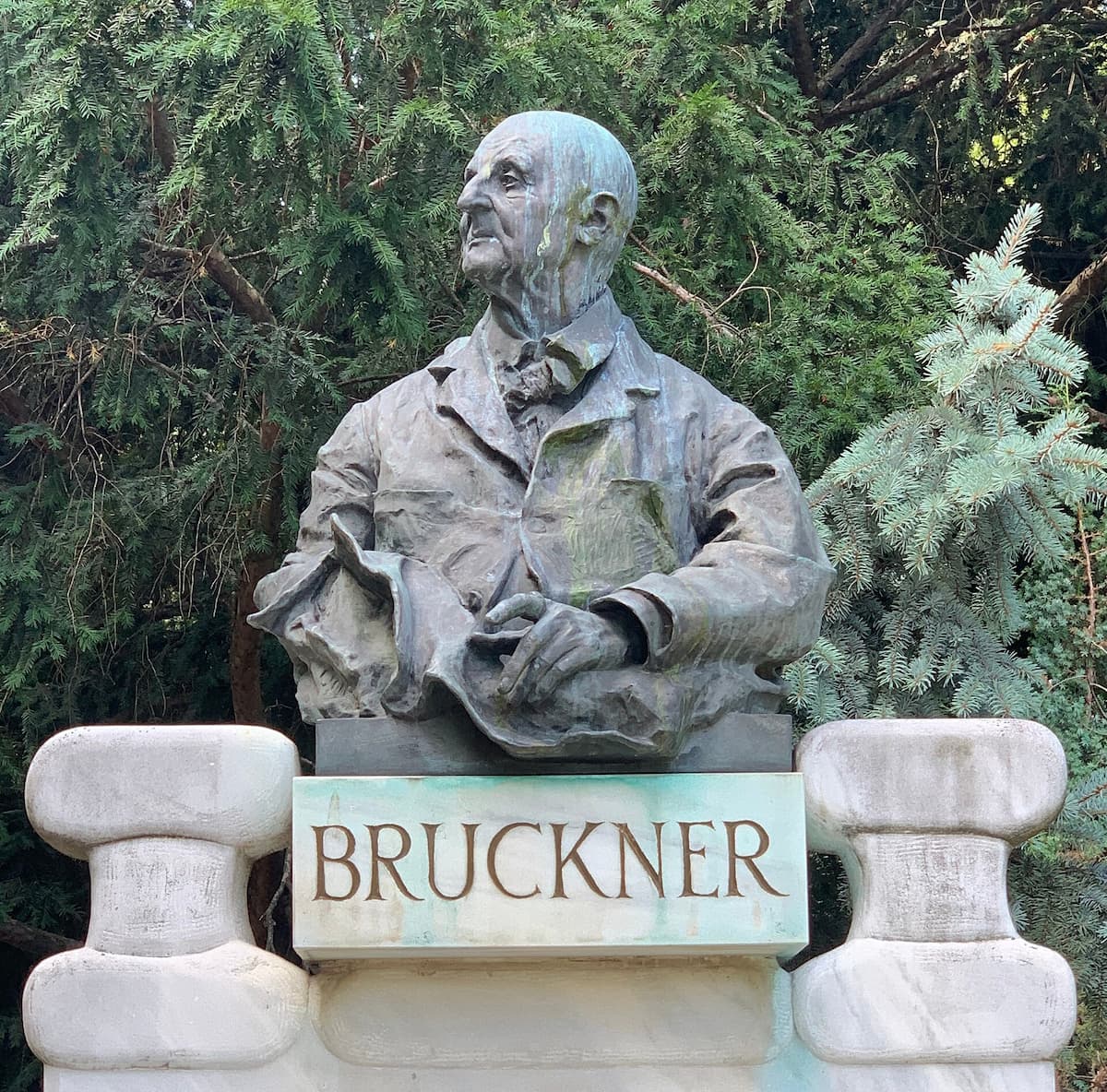
Anton Bruckner’s monument in Vienna
Despite his obvious musical abilities, Bruckner’s mother decided that he should follow in his father’s footsteps and become a schoolmaster. After taking teacher-training courses in Linz, Bruckner was sent to the remote village of Windhaag near Freistadt, where he remained as assistant schoolteacher for 16 months. A further teaching appointment saw him stationed at
Kronstorf an der Enns, but eventually, he returned to St. Florian for ten years to work as a teacher and an organist.
At the beginning of his second stay in St. Florian, Bruckner took on organ duties in the monastery church, and he dedicated himself to compositional studies aimed at improving his skills as a composer. He transcribed and analyzed works by Mozart, Michael and Joseph Haydn, and Beethoven. Bruckner remained a livelong learner, and he started to integrate these influences into his own improvisations and compositions. From about 1849 onward, almost 30 compositions were created at St. Florian.
Linz

Bruckner’s Ave Maria
During the early 1850s, Bruckner became increasingly frustrated with St. Florian, and he began to set his sights beyond the monastery walls. He unsuccessfully applied for the position of cathedral organist in Olmütz, but was more successful at Linz. His provisional appointment as cathedral organist was confirmed on 13 November 1855. Bruckner greatly enjoyed his time in Linz, a period that was essentially more stable and freer from controversies.
For six years, Bruckner studied counterpoint via correspondence with the famed Viennese theorist Simon Sechter, producing thousands of pages of exercises. Sechter later confessed that he had never had such an industrious student. Bruckner even took official examinations, and in addition to his legendary reputation as an improviser at the organ, he now produced his first masterpiece, the seven-voice Ave Maria first performed at Linz cathedral on 12 May 1861.
Idol Wagner
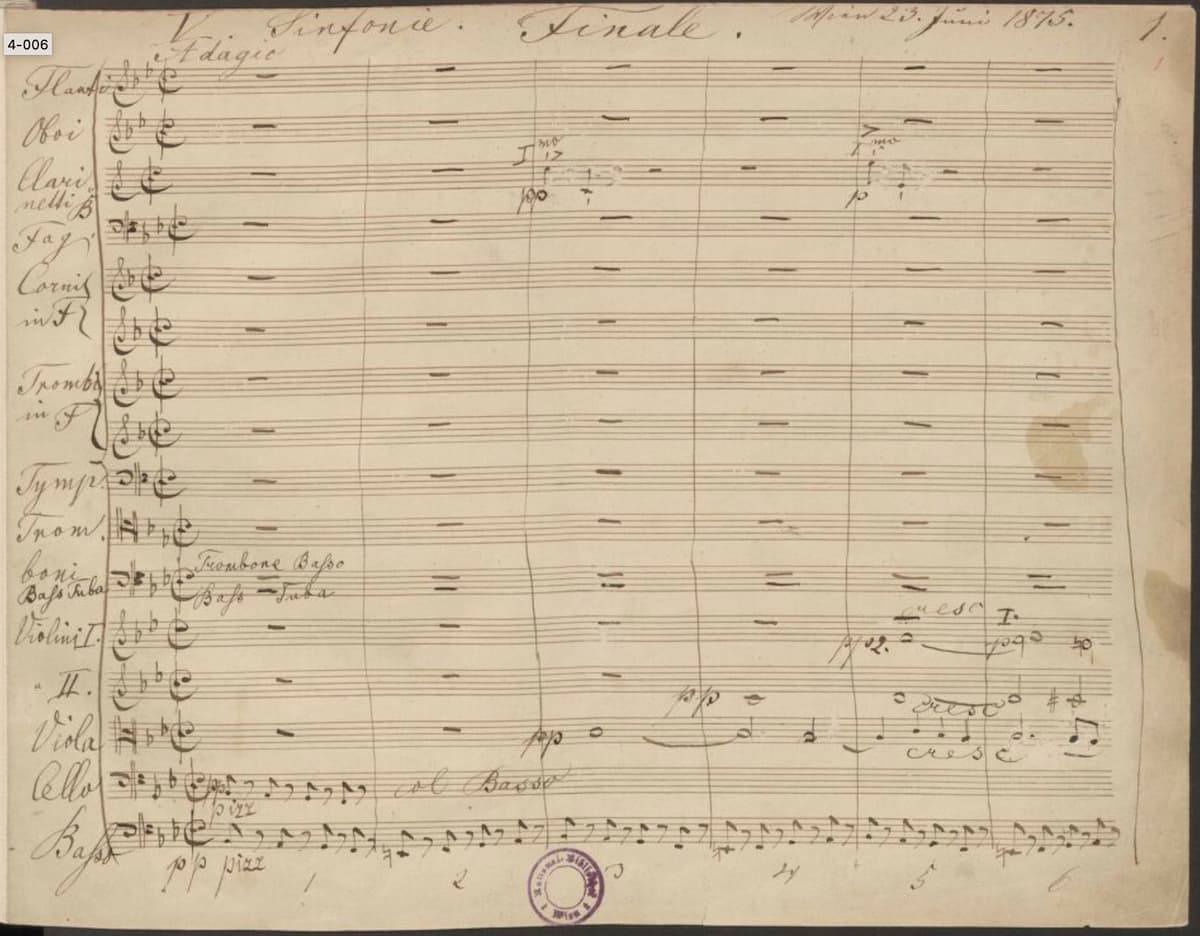
Bruckner’s autograph manuscript
In December 1861, Bruckner once again immersed himself in study, taking orchestration lessons with the German cellist and conductor Otto Kitzler. As Timothy L. Jackson writes, “Kitzler must be credited with bringing Bruckner up to date with 19th-century musical practices and introduced him to the music of Wagner.” For Kitzler, Bruckner composed a String Quartet, a “Study” Symphony in F minor, and a Psalm for double chorus and orchestra.
Bruckner first met his idol Wagner at the première of Tristan und Isolde in Munich in May 1865. Bruckner was fascinated by Wagner’s ideas about expanding the orchestra and his harmonic innovations, and he became a “fawning acolyte of Richard Wagner.” This hero worship would haunt Bruckner during his lifetime and posthumously. His total admiration is probably best demonstrated by Bruckner’s dedication of his Third Symphony. It reads, “To the eminent Excellency Richard Wagner the Unattainable, World-Famous, and Exalted Master of Poetry and Music, in Deepest Reverence Dedicated by Anton Bruckner.”
Vienna

The Bruckner Organ © stift-st-florian.at
Bruckner’s discovery of Wagner’s music at the age of 38 initiated a transition from meek church musician to bombastic symphonist. But first, Bruckner accepted Sechter’s post as a music theory teacher at the Vienna Conservatory. Bruckner was ill-prepared for the acidic and highly competitive musical environment of imperial Vienna. He presented a wide and easy target for music critics, journalists and composers alike, with most famously perhaps Johannes Brahms referring to him as a “country pumpkin.”
During his time in Vienna, which included an appointment at Vienna University in 1875, the symphony became the focus of his creative activity, starting with the so-called “Nullte,” No. 0. In a remarkable spurt of activity during 1870 and 1871, Brucker completed a series of four symphonies in little over two years. In general, the works were considered too long, and habitually plagued by debilitating periods of low self-esteem, Bruckner became preoccupied with revising earlier scores.
Symphonic Thoughts
Bruckner composed music that was simultaneously naïve and complex. Yet, once he had found his compositional path, the musical world did not know what to do with it. His “Wagner” Symphony No. 3 received a disastrous premiere in December 1877. Bruckner, never a successful orchestral conductor, was forced to take the podium. A scholar writes, “The orchestra was rebellious; the audience streamed out of the hall during the Finale and Hanslick wrote a blistering review.” As Bruckner reported to a friend, “I am once again alone in the face of adversity and misunderstanding.”
Amongst countless revisions of earlier works, the completion of the Fifth Symphony, a work he never heard performed during his lifetime, was followed by another remarkable series of works including the Sixth Symphony, the Seventh, the Eight, and the Te Deum. These works represent the summation of his symphonic journey. He was now blending Beethoven’s sense of preparation and suspense, mystery, and the ethical content of music with Schubert’s extended harmonies and Wagner’s unhurried and gradual unfolding of instrumental music.
Character and Reception

Bruckner’s tomb
Admirers describe Bruckner as an unpretentious, modest man and a “daring innovator who shied away from no enterprise.” Detractors, and he certainly had many, recognised his originality yet found nothing of value in the “work of a modest Viennese church musician who lived a solitary dreamlike existence without ambition, and who had been dragged into the limelight by an excessive Wagnerian cult.” To be sure, Bruckner was decidedly out of place in Vienna as he retained his peasant speech and social clumsiness, and he had the disastrous inclination to fall in love with teenage girls.
His distracting compulsions ranged from obsessive preoccupation with financial security to a morbid fascination with corpses. Bruckner was painfully unaware of the intellectual and political currents of his day, and he exhibited a “Neanderthal male chauvinism that even his admirers found remarkable.” He allowed outside influences to shape the content of his music, and untangling the relative merits of Bruckner’s various versions has kept performers and scholars busy until this very day. Bruckner’s symphonic works, much maligned in Vienna in his lifetime, are finally an integral part of the symphonic repertoire.
Bruckner died in Vienna on 11 October 1896 at the age of 72. He is buried in the crypt of the monastery church at Saint Florian, immediately below his favourite organ.